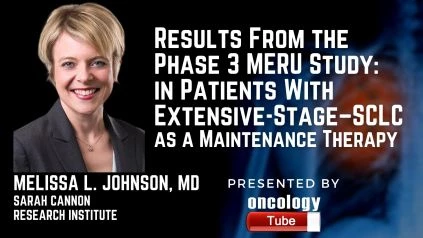Melissa L. Johnson, MD, Associate Director, Lung Cancer Research, Sarah Cannon Research Institute speaks about Rovalpituzumab Tesirine as a Maintenance Therapy After First-Line Platinum-Based Chemotherapy in Patients With Extensive-Stage–SCLC: Results From the Phase 3 MERU Study.
Link to Article:
https://www.jto.org/article/S1556-0864(21)02067-0/fulltext
Abstract:
Introduction:
DLL3, an unusual Notch ligand expressed in SCLC tumors, is targeted by Rovalpituzumab tesirine (Rova-T), an antibody-drug combination. After platinum-based chemotherapy, we compared the effectiveness of Rova-T vs placebo as a maintenance treatment in patients with advanced-stage–SCLC.
Methods:
MERU was a randomized, double-blind, placebo-controlled trial in its third phase. Patients who had not progressed following four rounds of platinum-based front-line treatment were given 0.3 mg/kg Rova-T or placebo in a 1:1 ratio (every 6 wk, omitted every third cycle). The Central Radiographic Assessment Committee evaluated progression-free survival (PFS) and overall survival (OS) in patients with DLL3-high malignancies as the primary efficacy end objectives.
Results:
All randomized patients (N = 748) were 64 years old on average, with 78 percent having TNM stage IV illness. The hazard ratio for OS was 1.07 (95 percent confidence interval: 0.84–1.36) in favor of the placebo arm in futility analysis of the subgroup with DLL3-high tumors, with median OS of 8.5 and 9.8 months in the Rova-T and placebo arms, respectively; futility criteria were satisfied. By investigator judgement, Rova-T significantly increased PFS compared to placebo (4.0 versus 1.4 mo, hazard ratio = 0.48, p 0.001). Pleural effusion (27 percent), reduced appetite (27 percent), peripheral edema (26 percent), photosensitivity response (25 percent), tiredness (25 percent), nausea (22 percent), and dyspnea were the most common any-grade adverse events in the Rova-T arm (20 percent) (21 percent ).
Conclusions:
The research failed not to reach its primary end objective and was prematurely discontinued due to the absence of survival benefit in the Rova-T arm. As a result, PFS was not evaluated by the Central Radiographic Assessment Committee. When comparing Rova-T to placebo, the frequency of grade 3 and drug-related toxicities was higher with Rova-T. Rova-T has been linked to a number of unusual adverse effects, including pleural and pericardial effusions, photosensitivity reactions, and peripheral edema, all of which should be carefully evaluated in patients with advanced-stage SCLC.

